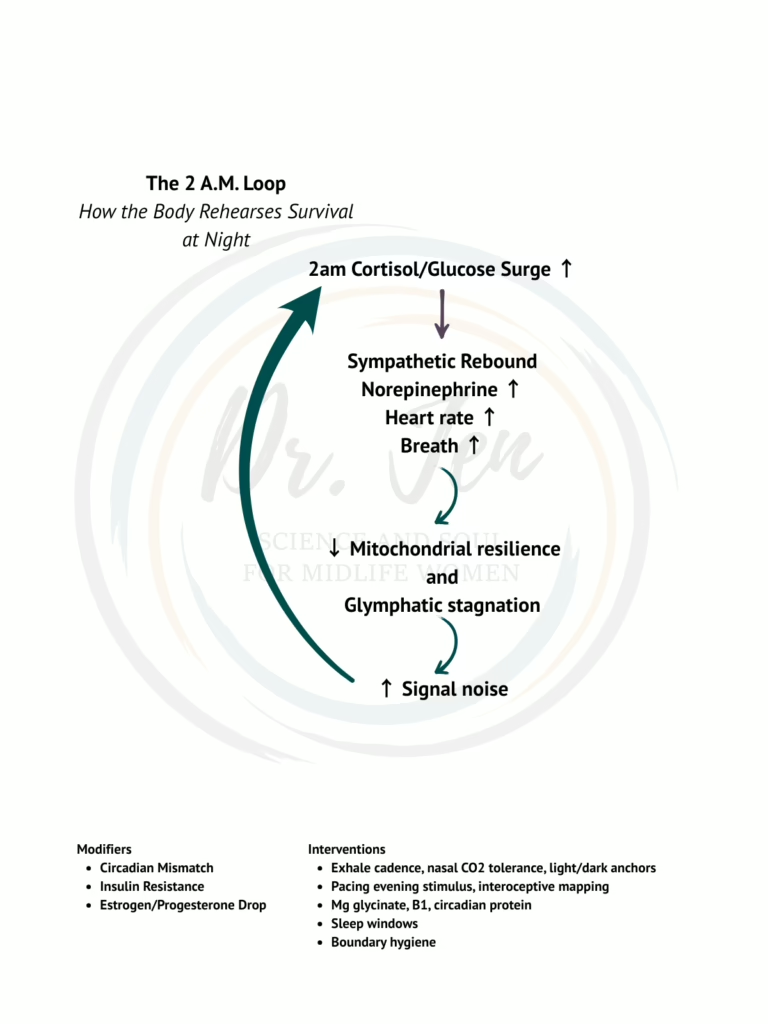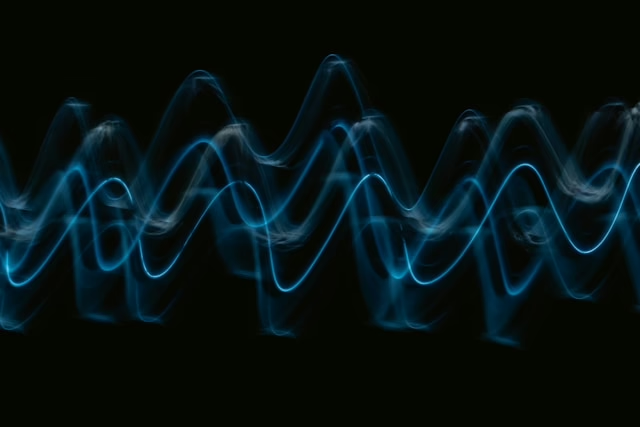🌕 Where nervous system wisdom rewrites the menopause playbook—part of The Reckoning Years series.
You’ve taken the magnesium.
You’ve done the bedtime yoga.
You’ve cut caffeine, bought the chili pad, and muted every notification after 8pm.
You fall asleep exhausted, only to bolt awake at 2:37 a.m.
Your brain switches on like it’s time to solve world hunger.
You toss, sweat, replay conversations, shift pillows. By dawn, you’re wrung out and furious.
This is the reality of menopause sleep problems.
And here’s the reframe: they’re not random. They’re terrain signals.
The Reframe: Sleep Is a Trust Issue
You can’t trick your body into rest when it’s still braced in survival mode.
And survival mode isn’t just “big trauma”—it’s decades of holding everyone else up while pretending you’re fine.
Sleep isn’t a prize for doing everything right.
It’s a byproduct of body trust.
The Myth of “Just Hormones”
Most explanations stop at: hormones drop, sleep tanks.
That’s true — but not enough.
Menopause sleep problems aren’t caused by estrogen and progesterone decline alone. If they were, hormone replacement would fix everything. Many women still wake drenched, restless, or wired even with balanced labs. Why? Because hormones are scaffolding, not foundation. When scaffolding recedes, the terrain underneath gets revealed.
The Terrain Roots of Menopausal Sleep Problems
Sleep disruption in menopause unmasks the body’s hidden weak links. Here’s what’s really going on:
- Estrogen withdrawal exposes fragility. Estrogen once buffered serotonin and vascular tone. Without it, hot flashes, night sweats, and restless blood vessels jolt you awake.
- Progesterone loss weakens the brake. Less GABA support means your brain has fewer calming signals. Every tiny noise or thought becomes a wake-up call.
- Blood sugar volatility triggers cortisol surges. That classic 3 a.m. wake? It’s often your body panicking from a glucose dip, firing cortisol to pull you back into alert mode.
- Inflammation and clearance bottlenecks stall the glymphatic system. Your brain’s night-shift detox crew only runs when inflammation is low and the nervous system is settled. If cytokines are high, waste doesn’t clear, and your brain spins instead of sleeps.
- Sympathetic overdrive keeps you armored. Decades of fight-flight override mean your system doesn’t know how to power down. Menopause strips away buffers, so the chronic brace shows up as insomnia.
None of this is random. Menopause sleep problems are predictable once you decode the terrain.

What It’s Not
It’s not dementia.
It’s not a moral failure to “sleep wrong.”
It’s not inevitable decline.
The flip-flop nature of menopause sleep problems — one night you sleep fine, the next you’re wired until dawn — reveals interference, not neurodegeneration. Interference can be cleared. Decline cannot. That’s why you must reframe insomnia as signal, not proof of loss.
🌟 Through the Vital Clarity Code Lens
Here’s how the Vital Clarity Code translates menopause sleep problems from defect to signal:
🌱 Regulate
Sleep after menopause isn’t restored by hacks or apps. It returns when your system trusts it can let go.
That trust is built in the rhythm of your days. Morning light on your face, food with weight and stability, blood sugar that doesn’t drop you into 3 a.m. panic. By evening, it’s not control you’re after — it’s quieting the static. An exhale longer than your inhale, the unclenching of your jaw, the reminder that your body isn’t on watch duty anymore.
Regulation is the soil. Without it, nothing holds.

🌀 Rewire
Once the scaffolding of estrogen and progesterone has fallen away, your nervous system has to learn a different architecture. Cortisol becomes the metronome of your nights, so steadiness depends on how you eat, how you pace, how you let tension move.
Neurotransmitters need material: magnesium, glycine, B-vitamins — not as supplements to chase, but as nourishment that makes transition possible. Circadian cues must be carved back into the body: daylight at dawn, darkness at night, rhythm re-etched through repetition.
Rewiring is not optimization. It is teaching a system stripped of its buffers to find a new way home.
🔥 Reclaim
This is the refusal to collapse into the story of being a “bad sleeper.”
Waking at night isn’t failure. Sensitivity to sound, heat, or sugar isn’t weakness — it’s intelligence. Reclaiming sleep means owning the signals instead of shaming them.
It means saying: my body isn’t broken; it’s demanding alignment.
✨ Resonate
On the other side of vigilance lies rhythm. At first it comes quietly — a shorter wakeup, a faster return to sleep, a morning without the hollow drag. Then coherence builds.
Resonance is not perfection. It’s the nervous system bending without breaking, nights stitched back into cycles instead of fragments.
Sleep stops being a battle. It becomes a conversation again.
🪶 Micropractice: The Busy Brain Dump
Before bed, set a timer for five minutes. Grab a notebook and spill everything—tasks, worries, reminders, random scraps. Don’t edit, just empty. When the timer dings, stand up, walk a lap around the room, and close the notebook.
Then place your hands on your belly. Take three long exhales. Remind your body: “The list is held. I don’t have to hold it.”
This isn’t productivity. It’s nervous system closure.
What Rebuilding Sleep Feels Like
At first, menopause sleep problems don’t vanish. You still wake up. You still sweat. But the edges soften:
- You fall back asleep in 20 minutes instead of two hours.
- Night sweats shrink from five episodes to one.
- You wake feeling human, not hollow.
Sleep restoration doesn’t look like a miracle. It looks like margin creeping back in. Every cycle teaches your nervous system to bend instead of break.
TL;DR
If you’ve tried all the tricks and still can’t sleep, stop blaming the sleep.
Your body isn’t broken—it’s communicating.
Menopausal wake-ups aren’t random; they’re capacity signals.
Curious what it looks like to map your pattern?
Start with a Vital Signal Check →
This post lives within the Menopause Hub, where we decode hot flashes, sleep changes,
weight shifts, libido, and brain fog through the lens of capacity, metabolism & the nervous system.
Also see the Sleep Hub for CO₂, circadian rhythm & night waking →
